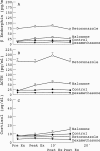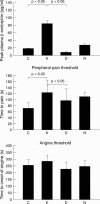Effect of raised plasma beta endorphin concentrations on peripheral pain and angina thresholds in patients with stable angina
- PMID: 10409537
- PMCID: PMC1729135
- DOI: 10.1136/hrt.82.2.204
Effect of raised plasma beta endorphin concentrations on peripheral pain and angina thresholds in patients with stable angina
Abstract
Objective: To determine whether changes in plasma concentrations of beta endorphins alter angina threshold and peripheral pain threshold in patients with stable angina.
Design: Latin square design comparison of angina thresholds by exercise treadmill test and peripheral pain thresholds using a radiant heat source in eight patients with stable angina under control conditions, after stimulation of pituitary beta endorphin release by ketoconazole, after suppression of pituitary beta endorphin release by dexamethasone, and after blockade of opioid receptors by intravenous naloxone.
Results: An approximately fivefold increase in circulating concentrations of beta endorphins was found after administration of ketoconazole (mean (SEM): 13.9 (1.2) v 73.8 (6.2) pg/ml; p < 0.05), which was associated with an increase in peripheral pain threshold to a radiant heat source (time to onset of pain perception 72 (19) v 123 (40) seconds; p < 0.05), but no significant difference in angina threshold. A reduction in circulating concentrations of beta endorphins after pretreatment with dexamethasone was statistically non-significant (13.9 (1.2) v 9.0 (1.5) pg/ml; NS) and was not associated with any change in either peripheral pain or angina thresholds. No effects were seen after blockade of opioid receptors by previous administration of intravenous naloxone.
Conclusions: Increased plasma concentrations of beta endorphins alter peripheral pain threshold but not angina threshold in patients with stable angina pectoris.
Figures



Similar articles
-
Effects of hypophysectomy and dexamethasone treatment on plasma beta-endorphin and pain threshold during pregnancy.Brain Res. 1987 Aug 18;418(1):138-45. doi: 10.1016/0006-8993(87)90970-x. Brain Res. 1987. PMID: 2959351
-
Effect of physical exercise on pain thresholds and plasma beta-endorphins in patients with silent and symptomatic myocardial ischaemia.Eur Heart J. 1988 Dec;9 Suppl N:25-33. doi: 10.1093/eurheartj/9.suppl_n.25. Eur Heart J. 1988. PMID: 3246253 Clinical Trial.
-
The relationship between plasma beta-endorphin, opioid receptor activity, and silent myocardial ischemia.Clin J Pain. 1992 Dec;8(4):307-16. doi: 10.1097/00002508-199212000-00005. Clin J Pain. 1992. PMID: 1337291 Clinical Trial.
-
Searching for an inhibitory action of blood-borne beta-endorphin on LH release.J Reprod Fertil Suppl. 1987;34:9-16. J Reprod Fertil Suppl. 1987. PMID: 2957499 Review.
-
Endorphins and pain perception in silent myocardial ischemia.Am J Cardiol. 1988 Apr 21;61(12):3F-8F. doi: 10.1016/0002-9149(88)90045-8. Am J Cardiol. 1988. PMID: 2965855 Review.
Cited by
-
Treatment with double dose of omeprazole increases β-endorphin plasma level in patients with coronary artery disease.Arch Med Sci. 2010 Apr 30;6(2):201-7. doi: 10.5114/aoms.2010.13896. Arch Med Sci. 2010. PMID: 22371748 Free PMC article.
-
Effects of recreational physical activity and back exercises on low back pain and psychological distress: findings from the UCLA Low Back Pain Study.Am J Public Health. 2005 Oct;95(10):1817-24. doi: 10.2105/AJPH.2004.052993. Am J Public Health. 2005. PMID: 16186460 Free PMC article. Clinical Trial.
-
Metformin increases pressure pain threshold in lean women with polycystic ovary syndrome.Drug Des Devel Ther. 2016 Aug 3;10:2483-90. doi: 10.2147/DDDT.S109086. eCollection 2016. Drug Des Devel Ther. 2016. PMID: 27536069 Free PMC article.
-
Decoding the "Pain-to-Door" interval using psychological, medical, and demographic factors: A multi-center study.PLoS One. 2025 Jun 30;20(6):e0325140. doi: 10.1371/journal.pone.0325140. eCollection 2025. PLoS One. 2025. PMID: 40587441 Free PMC article.
-
Development of a mammalian neurosensory full-thickness skin equivalent and its application to screen sensitizing stimuli.Bioeng Transl Med. 2023 Jan 3;8(3):e10484. doi: 10.1002/btm2.10484. eCollection 2023 May. Bioeng Transl Med. 2023. PMID: 37206205 Free PMC article.
References
MeSH terms
Substances
LinkOut - more resources
Full Text Sources
Medical
Miscellaneous
